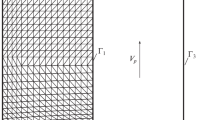Abstract
Oxidation induced stacking faults have been observed to function as dislocation generating sources in silicon single crystals when the crystals are annealed at high temperatures. The presence of diffused boron in the silicon results in a large increase in the size of the dislocation colonies generated from the faults. The dislocations generated form three dimensional star shaped colonies with the colonies being decorated by a second phase in the form of fine precipitates or dislocation loops. Depending upon the initial oxidation temperature and the postoxidation annealing treatments both partial and whole dislocations are generated in the samples containing diffused boron. The partial dislocations are 1/3 «111» Frank dislocations and the whole dislocations have Burgers vectors 1/2 «110» and «100». The dislocation loops generated are interstitial and the stacking faults extrinsic in nature. A model is proposed to account for the growth of the colonies. The initial nucleation of the stacking fault is suggested to occur by the formation of an oxide of silicon. Diffusion of boron is postulated to result in a preferential accumulation of boron in the fault with the subsequent growth of the fault occurring when annealing forces in-diffusion of the boron concentrated in the faults.
Similar content being viewed by others
References
K. V. Ravi:Met. Trans., 1972, vol. 3, p. 1311.
J. Bardeen and C. Herring:Imperfections in Nearly Perfect Crystals, W. Shockley, ed., p. 261, John Wiley and Sons, Inc., New York, 1952.
H. J. Queisser and P. G. G. VanLoon:J. Appl. Phys., 1964, vol. 35, p. 3066.
D. J. D. Thomas:Phys. Status Solidi, 1963, vol. 3, p. 2261.
A. W. Fisher and J. A. Amick:J. Electrochem. Soc, 1966, vol. 113, p. 1054.
G. R. Booker and W. J. Tunstall:Phil. Mag., 1966, vol. 13, p. 71.
M. L. Joshi:Acta Met., 1966, vol. 14, p. 1157.
J. M. Silcock and W. J. Tunstall:Phil. Mag., 1964, vol. 10, p. 361.
S. Dash and M. L. Joshi:Proceedings of a Symposium held at Gaithersburg, Maryland, 1970, Natl. Bur. Stand. Spec. Publ. No. 337, U.S. GPO, Washington, D.C.
I. R. Sanders and P. S. Dobson:Phil. Mag., 1969, vol. 20, p. 881.
R. J. Jaccodine and C. M. Drum:Appl Phys. Lett., 1966, vol. 8, p. 29.
A. Mayer:RCA Rev., 1970, vol. 31, p. 414.
L. Fiermans and J. Vennik:Phys. Status Solidi, 1965, vol. 12, p. 277.
L. Fiermans and J. Vennik:Phys. Status Solidi, 1967, vol. 21, p. 627.
L. Fiermans and J. Vennik:Phys. Status Solidi, 1967, vol. 22, p. 463.
E. Nes and J. Washburn:J. Appl. Phys., 1971, vol. 42, p. 3562.
C. R. Booker and R. Stickler:Brit. J. Appl. Phys., 1962, vol. 13, p. 446.
E. Sirtl and A. Adler:Z. Metallk., 1961, vol. 52, p. 529.
J. Whelan and P. B. Hirsch:Phil. Mag., 1957, vol. 2, pp. 1121, 1303.
P. B. Hirsch, A. Howie, R. B. Nicholson, D. W. Pashley, and M. J. Whelan:Electron Microscopy of Thin Crystals, Butterworths, London, 1965.
P. B. Hirsch, A. Howie, and M. J. Whelan:Phil. Trans., 1960, vol. A252, p. 499.
A. Howie and M. J. Whelan:Proc. Roy. Soc, London, 1961, vol. A262, p. 217.
M. J. Ashby and L. M. Brown:Phil. Mag., 1963, vol. 8, p. 1083.
Shiro Horiuchi and Jio Yamaguchi:J. Appl. Phys., Japan, 1962, vol. 1, p. 314.
A. Fourdeaux and A. Bergezan:C. R. Acad. Sci., Paris, 1961, vol. 252, p. 1462.
P. B. Hirsch, A. Howie and M. J. Whelan:Proc. Roy. Soc, London, 1962, vol. A267, p. 206.
J. D. Embury and R. B. Nicholson:J. Inst. Metals, 1962-63, vol. 91, p. 119.
R. M. Thomson and R. W. Balluffi:J. Appl. Phys., 1962, vol. 33, p. 803.
Author information
Authors and Affiliations
Rights and permissions
About this article
Cite this article
Ravi, K.V. Dislocation sources in silicon. Metall Trans 4, 681–689 (1973). https://doi.org/10.1007/BF02643075
Received:
Issue Date:
DOI: https://doi.org/10.1007/BF02643075




